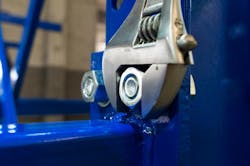Ask the typical tradesman, “Do you know how to use a wrench?” and you’re guaranteed the answer will be yes. But look at the nuts and bolts on brackets, bus bar, grounding lugs, and everything else that’s bolted together, and you might arrive at a different answer.
Many of those fasteners no longer have the sharp corners they came with. This can make removal difficult, even dangerous. And to the skilled mechanic, it just looks like poor workmanship. Which it is.
Maybe you don’t round the nuts and bolts, but have you slipped with the wrench or socket? If so, you’ve no doubt degraded those edges (shine a bright light and look, next time you slip). The next person does this and the next, and eventually you’ve got a knuckle-buster waiting to happen.
Your first line of defense is to possess an array of open-end and box-end wrenches of various standard sizes or at least the sizes you’re likely to encounter in your work. Always buy top-quality wrenches made for industrial use. They cost more, but they last a lifetime and are made with more precision than the cheap knock-offs, so they correctly fit the fastener.
Adjustable wrenches may save the day when you don’t have the size you need, but use an adjustable only when you don’t have the size you need. If you use an adjustable wrench, position it in the correct direction, if there’s enough room to do so. That is, you want the force to be applied to the side with the non-moving jaw. This actually helps lock the wrench in place (the other way has the opposite effect).
So your hand needs to be pushing on the non-moving jaw side of the wrench. If this tightens when you want to loosen (or vice-versa), turn the wrench over. Always adjust the wrench tightly once it’s in place and check the adjustment just before each turn. If you lift the wrench, check the adjustment once you put it back down on the fastener.
Whether or not your wrench is adjustable, your next concern is alignment. Most people aren’t concerned about this, and that’s why they slip with the wrench.
To avoid slipping, place the wrench jaws on the fastener as square as possible. You want to align the surfaces of the wrench perfectly with the surfaces of the fastener, in all three dimensions. Practice drawing an imaginary line with your eye. One reason people slip with the wrench is it’s not square with the work.
This alignment will put the handle of the wrench in the correct position. But if you push the wrench from an odd angle, you’ll push it off the fastener. That’s another reason people slip with the wrench. They don’t align the applied force with the tool and the work.
A similar thing applies when using sockets. A socket on an angle (perhaps off vertical when being used directly over the work) is at a high risk of slipping.
Now if this all sounds like much ado about nothing, here’s your challenge. Quickly put a wrench to a bolt or nut, just the way you always do. Then mentally draw those invisible alignment lines and notice the discrepancies. Almost everybody has these. To further drive home the point, watch your work partner operate a wrench, and mentally draw those lines. Don’t say anything beforehand, just watch and draw.
With a little practice, you can do this quickly. Make it a habit, and you will never round a nut or bolt.





